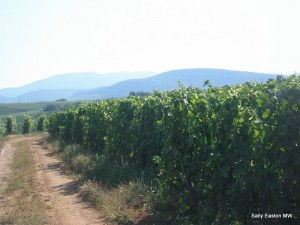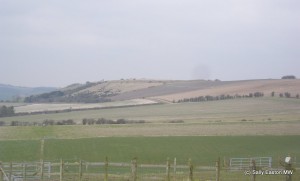Climate change winners and losers
A version of this article first appeared in Winestate magazine, May/June 2015.
A changing climate is affecting us all, though humans probably have more adaptability than plants. And grapevines producing high quality fruit for wine are especially sensitive to climate change.
It’s easy to forget that wine is an agricultural product. A vine’s growth and quality each year is subject to the climate in which it is grown and the weather patterns in each season. Vines are pretty specific as to their preferred climate – they only grow in temperate climates. Within the temperate climate, each vine variety has an even narrower range of preferred growing conditions. According to Professor Greg Jones, a climate change specialist, average growing season temperature for grape varieties ranges from about 13°C, for the likes of pinot gris/grigio and gewurztraminer to around 20°C for cultivars such as nebbiolo and zinfandel. Each grape variety can tolerate only a few degrees range of average temperature, so 13-15°C for pinot gris and 17-20°C for nebbiolo. Outside the range and the grape variety doesn’t ripen or over-ripens, and the best quality fruit may come from an even tight temperature range.
Temperature is arguably the most important key performance variable for vines. As well as informing which variety grows in which narrow location band, anytime it gets too hot, between 30 and 35°C, enzymes stop working and the vine shuts down.
Rain is another important one. Climate change appears to be bringing more extreme weather events and anomalies, among them flood and drought. In Europe, more widely legalising irrigation may help with drought issue, though the cost of building infrastructure to supply irrigation may outweigh the benefit, especially if there is a lack of rainfall at other times to fill reservoirs for use during drought periods. This is one of the dilemmas especially for warmer Mediterranean regions where current annual rainfall levels are already not particularly high. Spain’s La Mancha has only 300mm annual rainfall, a situation that has hitherto been managed by extremely low planting densities and drought-resistant grape varieties.
Last year, 2014, was the hottest year on record [since superseded by 2015]. The average annual temperature was 0.7°C above the average of the 20th century. That eats quite a long way into those narrow preference bands for grape varieties. In line with this, Europe experienced its hottest year in 2014. It’s far from a one-off. The IPCC (Intergovernmental Panel on Climate Change) reckon the average annual temperature in the northern hemisphere in the 30 year period from 1983 to 2012 was the warmest 30 year period in 800 years.
Looking forward, depending on which modelling scenario used, the IPCC forecasts global temperatures are likely to rise by more than 1.5°C, or more than 2°C, by the end of this century, compared to the situation in the second half of the 1800s. According to another report these scenarios suggest viticultural land may decrease by 20 to more than 70%. That would fundamentally change the wine world as we currently know it; whichever of the IPCC’s scenarios unfolds, it looks set to be a dramatically life-changing scenario for European viticulture.
But it’s not all doom and gloom. Europe might be very roughly the same size as Australia, but it experiences a wide variety of climates, from the sunny Mediterranean to the (hitherto) frozen Arctic Circle.
The forecast temperature increase puts southern regions around the Mediterranean in jeopardy, whilst the cool and cooler climates of northern European regions may, in fact, accept a positive outcome from a degree of warming. Indeed in 2014, the UK basked in warmth, amid viticulturally welcome episodes of rain, and had a large, high quality crop. Such northerly latitudes are possible winners in the climate change lottery.
Other European ‘winners’ of climate change could include other northern European countries such as Denmark, Sweden, Belgium Netherlands, Poland, as well as the far north of France, and bits of the Pyrenees Mountains, between France and Spain. In the same way that Australia increasingly looks to high altitude (Macedon Ranges / Orange) and high latitude (Tasmania), so it may be necessary for Europe. There may even be opportunity in the Baltic states of Lithuania and Latvia.
Nascent wine production cultures have already started in the Netherlands, Denmark and Sweden; a little, even, in Norway. The UK’s production is more advanced, with the country having roughly the same vineyard acreage as Tasmania. For the UK, these 1800ha are the most that have been planted.
Novelty is often easier to introduce, but for the traditional, big-producing regions of the far Mediterranean south of Europe, adaptation to higher average temperatures may be more challenging. It is entirely possible that swathes of vineyard area may be entirely lost.
Possible losers under a changed climate include central and southern Spain, including Ribera del Duero and Rioja, France’s Languedoc-Roussillon, Bordeaux, and southern Rhone, as well as southern and central Italy, including Tuscany. Even Burgundy is unlikely to go unscathed.
What are the options in these locations? Adaptive canopy management strategies, for example more shading, may help in the short term. Irrigation may help the drier south in the medium term.
Beyond that, once the existing strategies have run their course, given the vine’s locational sensitivities, one option is to plant different grape varieties in existing appellations. This would overturn the very basis of the way we think about terroir and the exquisite matching of site with variety. But it’s an option. Some grape varieties are more forgiving than others as to their growing locations. Chardonnay and cabernet sauvignon are pretty gregarious and adaptable. No wonder they are both very widely planted across the wine-producing world. But pinot noir, we know, is much more fickle and fastidious and quickly gets very grumpy when it is outside its rather geographically restricted comfort zone. Such a specificity of growing location for each cultivar makes them particularly vulnerable to changes in climate.
Should you expect your Bordeaux wine to be made from grenache, mourvedre (mataro) and carignan (mazuelo)? Burgundy from cabernet franc and merlot, perhaps? It feels at the moment a bit like it’s one step too far for the brain to compute.
It’s easier to compute the creation of those new viticultural regions nearer the Arctic. But even some newer regions may not be as long lived as current wine growing regions have been. The UK’s sparkling wine industry may be being built on the same geology as that found in Champagne. And the Kimmeridgian soils of Chablis get their name from a little place called Kimmeridge in Dorset, on the south coast of England. The auspices may be initially good, but another climate change report suggests these southerly England locations may already be so warm by 2080 that they’re growing grapes for raisins.
Bottom line: the perceived immutability of European wine regions is no longer something we can take for granted. Generational adaptation may have to become the wine industry norm.





